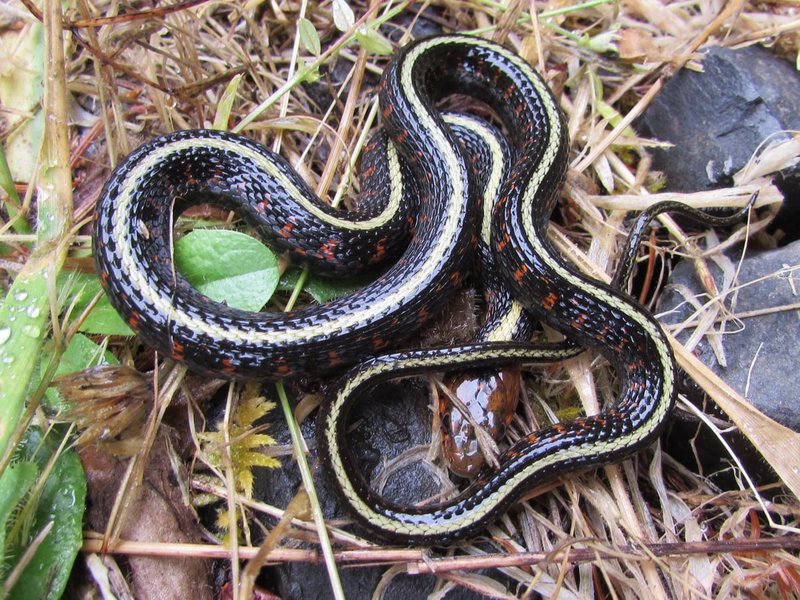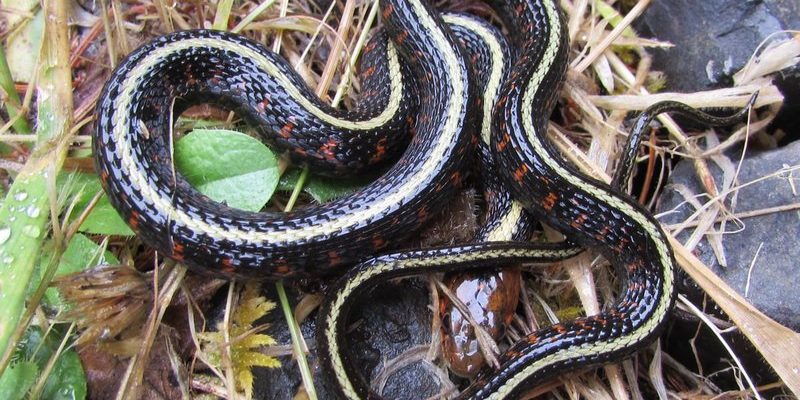
Have you ever spotted a snake slithering through the grass and wondered what it was? If so, you might have encountered a garter snake. These fascinating creatures are among the most common snakes in North America, and they come with a variety of colors and patterns that usually catch the eye. Imagine a tiny green ribbon weaving its way through your garden; that’s the charm of a garter snake!
Typically, garter snakes are not only harmless to humans but also play a crucial role in the ecosystem. They’re like nature’s pest control, keeping the population of rodents and insects in check. Plus, they have some really interesting behaviors and characteristics that make them stand out in the snake world. So let’s dive into the world of garter snakes and uncover the secrets behind these remarkable reptiles.
What is a Garter Snake?
The term “garter snake” refers to several species in the genus Thamnophis, which includes around 35 different species. These snakes are named after the characteristic stripes that run down their bodies, resembling the garters worn to hold up socks. Garter snakes can be found in various habitats, from woodlands to wetlands, making them one of the most adaptable snake species around.
These snakes typically range from about 18 to 54 inches in length, depending on the species. While many have a striking green or brown color, some may display vibrant hues of blue and yellow. Their appearance can differ widely, with markings that aid in camouflage against predators. Isn’t it incredible how nature gives them these protective adaptations?
Physical Characteristics
Garter snakes are slender and agile, with a streamlined body that allows them to move swiftly through grass and water. The dorsal scales are smooth, which helps reduce friction as they slither. Most garter snakes exhibit a pattern of longitudinal stripes, which can help them blend into their surroundings, particularly in dense vegetation.
Their eyes are quite distinctive, often with round pupils that help them see well in low light. A unique feature of many garter snakes is their forked tongue, which they use to sense their environment. By flicking their tongues, they can pick up scent particles from the air, helping them find food and navigate their surroundings.
Another cool characteristic is their ability to change color slightly based on their mood and environment. When threatened, some may become more vibrant to confuse predators, acting like a natural chameleon as they blend into their habitats.
Habitat and Range
Garter snakes are found across North America, from southern Canada to northern Mexico. They thrive in a variety of habitats, including forests, grasslands, wetlands, and even urban areas. You might find them lounging in the sun on a warm rock or hiding among the leaves and grass, making them surprisingly common yet often unnoticed.
These snakes prefer areas close to water sources, such as streams, ponds, or marshes. The moisture in these environments keeps their skin hydrated, which is essential for their survival. Garter snakes are also known to gather in groups during the colder months, often seeking shelter in burrows or beneath rocks to stay warm during hibernation.
Interestingly, many garter snake species have adapted to live in harsh environments, showcasing their resilience. For example, some can thrive in dry, arid lands, while others favor damp, lush settings. This adaptability has played a huge role in their widespread success as a species.
Diet and Feeding Habits
When it comes to dining, garter snakes are opportunistic feeders. They primarily feast on small animals, including rodents, amphibians, and insects. Their diet can vary depending on the availability of prey in their habitats. If you ever observe one of these snakes in action, you might be amazed at how quickly they strike!
As ambush predators, garter snakes rely on their stealth to sneak up on unsuspecting animals. They often hunt during the early morning or late afternoon when their prey is most active. Using their keen sense of smell, they track down their next meal and then use their sharp teeth to grasp and consume it.
Although garter snakes are non-venomous, they have been known to secrete a mild toxin, especially when consuming amphibians. This toxin helps to subdue their prey, making it easier to eat. It’s fascinating how they have evolved such clever ways to secure meals, even without the use of venom!
Behavior and Reproduction
Garter snakes are quite social compared to many other snake species. During the breeding season, which typically occurs in the spring, males will often gather in large groups to compete for female attention. It can be a real wrestling match as they try to impress and court potential mates!
After mating, female garter snakes typically give birth to live young, with a litter size ranging from 10 to 40 babies, depending on the species. The young snakes are independent right from birth, which is quite different from many other reptiles that need parental care. It’s like sending the kids off to college right after they’re born!
As the days get warmer, you’ll often see garter snakes basking in the sun to regulate their body temperature. They’re quite active and can often be spotted hunting or socializing, which adds a lively dynamic to their behavior. Their activity level makes them a joy to observe and adds to their charm.
Conservation Status
While garter snakes are generally abundant and widely distributed, some local populations are facing threats. Habitat loss due to urban development, pollution, and climate change can have negative impacts on their populations. Even though many species are currently considered of “least concern,” it’s essential to keep an eye on these changes.
Conservation efforts focus on preserving their natural habitats and educating the public about the importance of snakes in our ecosystems. Programs that encourage coexistence with wildlife can help mitigate human-wildlife conflict, ensuring that these incredible creatures continue to thrive.
So, next time you see a garter snake sunbathing in your garden or slithering through the grass, take a moment to appreciate its role in maintaining a balanced ecosystem. They may be small, but they play a big part in keeping nature in check!
Interesting Facts About Garter Snakes
| Fact | Description |
| Species Variety | There are over 35 species of garter snakes. |
| Size | Garter snakes can range from 18 to 54 inches long. |
| Diet | They primarily consume small mammals, amphibians, and insects. |
| Behavior | These snakes are social and often gather in groups. |
| Reproduction | They give birth to live young, usually in the spring. |
| Habitat | Garter snakes thrive in diverse habitats, especially near water. |
| Longevity | In the wild, they can live 4 to 10 years on average. |
FAQ
Are garter snakes dangerous to humans?
No, garter snakes are not dangerous to humans. They are non-venomous and generally shy. If approached, they may flee rather than confront a person. Their bites, while they can occur if threatened, are not harmful.
How can I identify a garter snake?
Identifying a garter snake is fairly straightforward due to their distinctive striped patterns. Most have a pattern of longitudinal stripes that can be green, brown, or even blue. They are slender and sleek, making them quite different from thicker, more robust snake species.
What do garter snakes eat?
Garter snakes primarily eat small rodents, amphibians, and insects. Their diet may vary based on what’s available in their habitat. They are also known for their ability to eat prey larger than their head, thanks to their flexible jaws.
Where do garter snakes hibernate?
During hibernation, garter snakes often seek shelter in burrows, under rocks, or in other warm, protected places. They tend to hibernate in groups, which can help them maintain warmth through the colder months of the year.
Can garter snakes swim?
Yes, garter snakes are excellent swimmers! They are often found near water sources and are quite comfortable moving through it. In fact, they can swim quite swiftly to escape predators or to hunt for food.
How long do garter snakes live?
In the wild, garter snakes typically live between 4 to 10 years, depending on environmental conditions and predation. In captivity, with proper care, they may live longer due to fewer threats.
What should I do if I find a garter snake in my yard?
If you encounter a garter snake in your yard, it’s best to leave it alone. They are beneficial for controlling pests and are harmless to humans. If you need to move it, gently guide it away from your porch or garden without harming it.
Do garter snakes make good pets?
Garter snakes can make good pets for those who are prepared to care for them properly. They are relatively easy to handle and are generally calm. However, it’s crucial to research their specific needs and ensure you can provide a suitable habitat.
Are all garter snakes the same color?
No, garter snakes come in a wide range of colors and patterns. While many display traditional stripes, some may be more solid in color or have variations in their markings. Their coloration can help them blend into their environment, aiding in their survival.
How do garter snakes regulate their body temperature?
Garter snakes are ectothermic, meaning they rely on external sources to regulate their body temperature. They often bask in the sun or seek shade to maintain an optimal temperature. This behavior is essential for their metabolism and overall well-being.
Do garter snakes have any natural predators?
Yes, garter snakes face threats from various predators, including birds of prey, larger snakes, and mammals. Young garter snakes, in particular, are vulnerable to these natural enemies. Their ability to camouflage helps them evade detection.
Can garter snakes climb trees?
Yes, garter snakes can climb trees, especially if there are branches or structures that assist them. Although they are primarily ground dwellers, their agility allows them to navigate vertical spaces when necessary.

